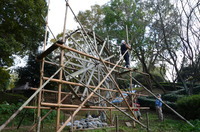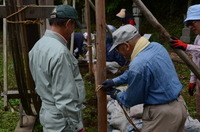

Total:35items

 |
|
 《Feature》
《Feature》"Kazusa-bori" is a deep well digging technology invented in Kimitsu city, Chiba Prefecture around 1887 (Late Meiji 20s).
Using Nishi Kazusa geography, diggers made groundwater flow. They dug numbers of wells for securing water for agricultural use and drinking that are still in use now. This technology was used not only for water but also hot springs and natural gas excavations.
Kazusa bori is known as a unique excavation technology that uses the bamboo, locally available material, and requires only few numbers of diggers. Its most specific feature is to provide the wells that the water naturally flows to the ground. Wells with this feature are called flowing or boring wells.
It is said that Kazusa-bori was originated in Obitsu and Koito districts, Kimitsu city. Both districts are located in middle reaches with river terraces that geographically made it difficult to secure water for drinking and agricultural use. Well-digging technology development was encouraged as the method to secure the better-quality water.
In Kazusa-bori method, a scaffold is set up with hanegi (bow-type bamboo spring) on its top. Using the bamboo resilience, the iron pipe (7m, 30kg) moves up and down crushing the layer to dig forward and its weight bores the ground. A circular chisel (iron tool for crushing the borehole ground) is fixed on the end of the iron pipe and the check valve is fixed inside the pipe.
As digging reaches beyond the pipe length, 7-8m higos (bamboo sticks)are additionally attached to the top of the iron pipe to dig further.Then the clay water with high specific gravity is poured into the hole to prevent collapsing. It is important to continue pouring the clay water to the hole as it cools down the chisel heated by friction and increases viscosity of the crushed mud to be removed easily.
Crushed sand and excavated mud are sucked into the "suiko", a cylindrical suction pipe for mud with a check valve fixed upper inside. A wood wheel "higo-guruma" (Diameter: around 4m) rotated by adigger inside moves the suiko and other tools up and down. Using hisweight, the digger operates the wheel to roll up the higo units boundwith a rope. Then, the suiko connected to the other side of the higo is lifted up to the ground to pour out the mud from the hole.
When the mud is removed, the iron pipe continues digging further and higos are attached to the pipe one after another. Repeating this process, the pipe can dig hundreds of meters deeper. When it reaches the aquifer, casing pipes are installed in the hole. In the past, Japanese timber bamboo sticks were popularly used as casing pipes. However, plastic or iron pipes replace with bamboo now in some cases.
In the past, Kazusa-bori technology supported people's lives and its useful method was introduced to overseas. With increased mechanization, it once ended its role in the '70s. However, for concerns of overseas cooperation in developing countries and protecting global environment, its eco-friendly tools and features are now regaining attention.
In March 15th 2006, The Agency for Cultural Affairs designated Kazusa-bori well digging as one of Intangible Folk Cultural Assets of Japan. Since then, "The Association for Preservation of Kazusa-boriTechnique" (Chairperson: Masayuki Tsuruoka), an official preservationgroup, has been proudly preserving and handing down this traditional technology to the next generation.
Translation: Eri Hara, reviewed by Marie Mine
| City/Town | [National Selected Intangible Folk Cultural Asset]
Provided by: Sodegaura-shi Folk Museum [Location] Kazusa Province, Chiba Prefecture |
|---|---|
| Location | "Kazusa-bori" Special exhibition space, Sodegaura-shi Folk Museum
1133, Shimonitta, Sodegaura-shi, Chiba Prefecture Telephone: +81-(0)438-63-0811 (Japanese only) |
| Contact | Sodegaura-shi Folk Museum
Tel: +81-(0)438-63-0811 (Japanese only) |
| Access | By car:
20 minutes from Anezaki-Sodeura interchange (Higashi Kanto Expressway Tateyama line). 15 minutes from Sodegaura interchange (Aqua-line). By train: Take JR Uchibo line and alight at Sodegaura station. By bus: Take the bus to Hirakawa Gyosei center/Nozomino Terminal and alight at Sodegaura Koen stop (Bus service on this route is not frequent. Please check the schedule). |
| Highlight/POI | Traditional technology that is popularly utilized in oversea well-digging projects, honoring an earth-friendly and classic technology. |
| General Participation | Sodegaura-shi Folk Museum offers "Kazusa-bori" learning program.
Date/Time: Early June (Scheduled on the day of the museum festival) The museum also offers "Kazusa-bori" tours as a traditional arts promotion activity. Date: Sunday Contact museum for reservation. Assistance needed? For inquiries in English: JTCO Contact Form Your inquiries will be forwarded by JTCO in Japanese to the organization you wish to contact. |



